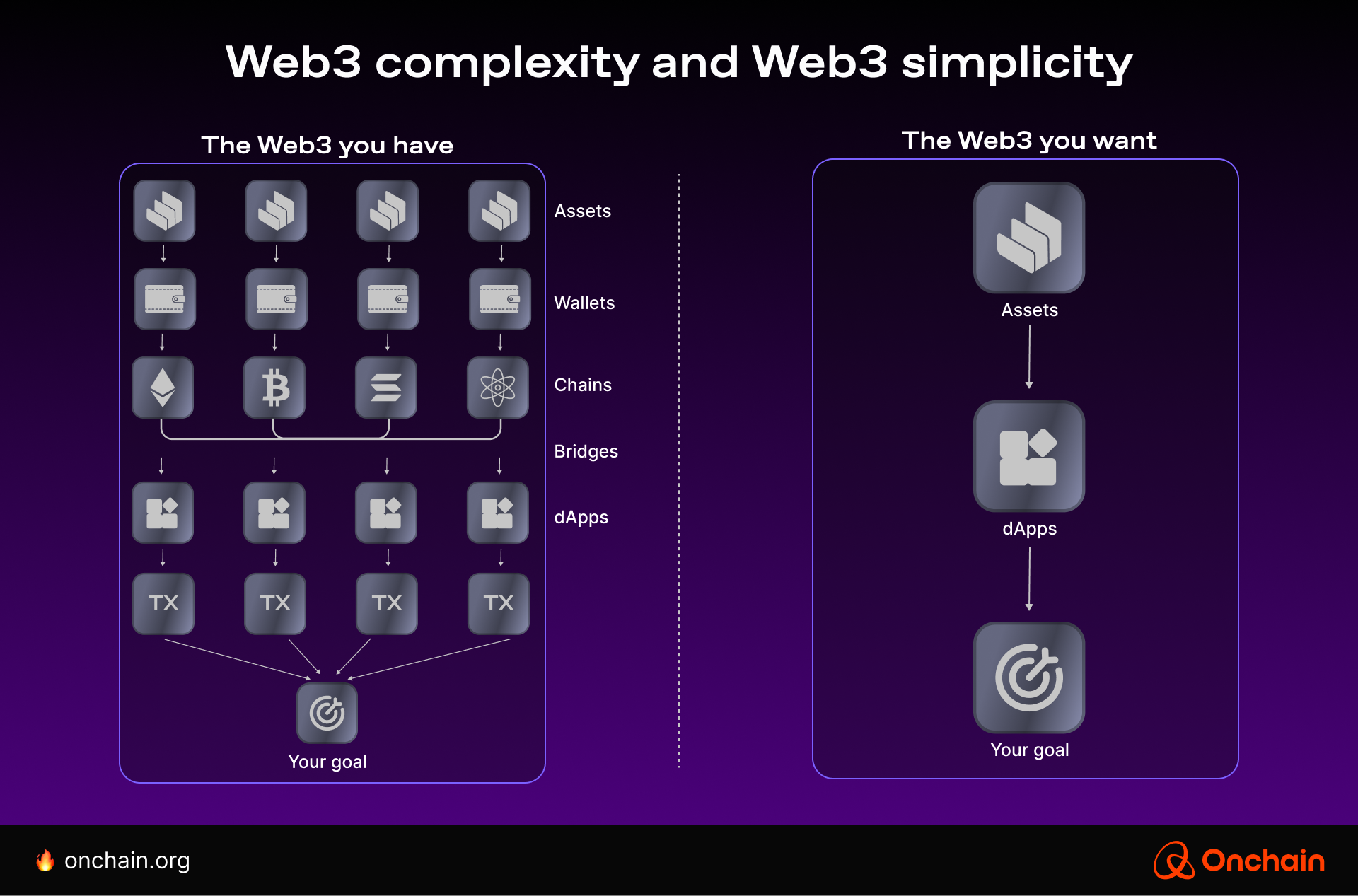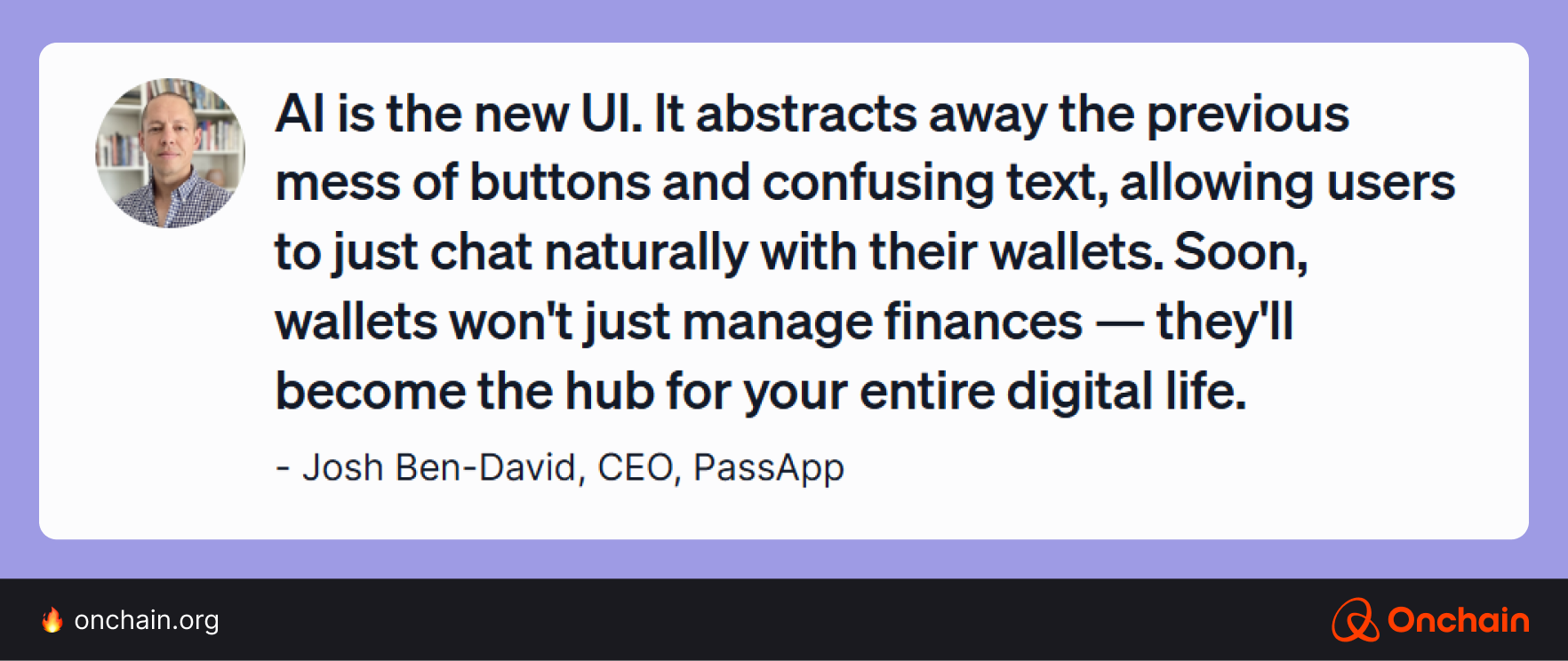Blockchain abstraction is just another way of saying you simplify the Web3 user experience. How? By keeping the onchain tech hidden in the background.
Putting the tech on prominent display isn’t helping users. There is really no need to take them behind the (crypto) curtain.
This clichéd expression rings true because we as humans desire unknown, hidden, or secret truths. While transparency and openness are concepts that strongly embody the crypto ethos, sometimes you want to hide away things you don’t want — or need — to see.
What is chain abstraction in crypto?
Blockchain abstraction means both hiding unnecessary technical details and automating tasks that previously required user input. It’s a process that makes Web3 crypto apps and tools simple, straightforward, and easy to use.
When done well, chain abstraction reduces onboarding and user friction. In a Web3 nutshell, chain abstraction hides the blockchain complexities under a sleek and friendly interface.
Who wants to go on a research mission to figure out how to migrate between blockchains, swap tokens, or connect your crypto wallet with a decentralized app (dApp) or exchange (DEX)? As a crypto user or creator, you want crypto apps that are intuitive and work well.
How does chain abstraction work?
Chain abstraction is onchain specific. However, the idea of abstraction is borrowed from computer science. More commonly known as “Make things simple and easy to use,” abstraction is a critical part of attracting and onboarding new users to your products and services.
This is why any big company has employees focused on the user interface (UI) and user experience (UX) of its products. When consumers decide between two similar products, they tend to go with whatever is simpler and easier to use.
Why do you need chain abstraction?
When chain abstraction works well, people are more likely to use, keep using, or recommend your app to others. When it doesn’t work well, it can frustrate or confuse them, or even make them downright angry.😠
For these users it’s a short step towards searching for a better alternative. That’s why, if you’re an aspiring Web3 entrepreneur or working on your next great onchain app, chain abstraction should be at the forefront of your mind when making UX/UI decisions.
Chain abstraction in the real world and why it makes a difference
Chain abstraction shouldn’t be an abstract concept. And it isn’t just related to the online and onchain realms that we all spend so much time in. Abstraction is all around you. Let’s drive you through an easy offchain example: cars.😜
You don’t need to be a mechanic or racecar driver to get on the open road. All you need is some standard driver training and a key (fob). These days, you don’t even need to know how to shift gears.
The concept of shifting gears has been almost completely abstracted away in the U.S. market. Only around 1% of cars sold having a manual transmission. It is estimated that less than 20% of Americans can drive a “stick shift” car.
Abstraction in Web1/2/3: a quick lesson in web history
In 2025, Web3 continues to go through a chain abstraction era where crypto products are becoming ever easier to use. You could liken it to the UX/UI improvements that took place with computers in the 1980s and 1990s.
I was once a young Web1 kid then. I used MS-DOS, an early operating system (OS), to play games in the 1990s. When I turned the computer on, it whirred away, and lines of code and the OS metrics flashed across the screen.
MS-DOS uses a command line interface (CLI), and you need to know some basic command prompts to get it started. Today’s Macs and PCs have OSs that abstract away nearly all of the complexity of early computers. You don’t need to know how to code to use your PC, tablet, or smartphone.
Still, the coding option lurks beneath your UI. On a Windows PC, I can open a coding box by holding down the Windows Key and R, typing “cmd,” and pressing enter. Boom, look at me, I’ve opened a basic CLI!

A CLI is a nice-to-have option for some things, but outside programmers and developers, it’s not a necessary thing you need to know how to do. Abstraction is a good thing. The last time I regularly used a CLI was in the 1990s.
Crypto chain abstraction is inevitable
You’ve explored the Web3 app world. So you must have noticed that some wallets and apps aren’t easy to use. Take my word for it if you weren’t there: It’s a lot better now than it was in the mid-to-late 2010s. 🤯
But the crypto app ecosystem still has a long way to go to abstract away chain complexity. A key goal of chain abstraction is increasing interoperability within the blockchain ecosystem. Chains, wallets, and apps may or may not be interoperable with each other.
When they are, it can be a complicated process of wrapping tokens, using bridges, having tokens to pay fees, and other issues. This can, at times, require you to have numerous wallets, crypto addresses, and other tools.
Wouldn’t it be nice if you could reach your goals with just a few apps and one wallet that could hold all your assets?

Chain abstraction examples in wallets, loyalty apps, and more
Long ago, in the Web3 dark ages, nearly every single blockchain and its token had a separate wallet. If you had eight different tokens, it likely meant you had eight separate crypto wallets. Since then, crypto wallets have come a long way.
Some of the first wallets to go multi-token and abstract away blockchain complexity include Exodus, MetaMask, Atomic, and Trust Wallet. Now, a new generation of crypto wallets is bringing enhanced multichain capabilities and simplifying the UX even more.
Web3 wallet chain abstraction
For example, Pass App lets you make seamless crosschain trades while using non-native tokens for swap transactions. Going a step further, Pass also incorporates AI elements that do some of the heavy onchain lifting.

One part of chain abstraction is hiding which blockchain(s) you are using. For many, Web3 abstraction means hiding the fact that it uses the blockchain at all.
If you’re in decentralized social media (DeSoc), do you think users really need to know what chain they’re posting on? For that matter, do they even need to know they’re interacting with an onchain social media app at all? Probably not.
Another way to simplify crypto transactions is with easier and more readable crypto addresses. For example, you could use an Onchain Domain. It simplifies transactions, builds your brand, and much more. If you don’t have one yet, get yours now.
The Blackbird loyalty app: onchain abstraction
The Web3 loyalty app Blackbird is another good example of chain abstraction. It feels like a standard app but also adds crypto elements like its stable FLY rewards and token incentives to drive value for app users. Users don’t need to know that FLY is onchain. They just need to see its monetary value when they dine out.
That’s the balance that crypto apps need to strike to catalyze adoption: Help users understand the benefits of blockchain without creating unnecessary complexity or confusion. In fact, with good Web3 apps like Blackbird, they might not even realize there is an onchain component.
And this is more common than you’d imagine. Millions use Web3 apps without even realizing it.
Benefits of chain abstraction
Simplicity is great, but what does that mean in practice? For one, it flattens the learning curve for Web3 engagement. Crypto complexity turns many away before they’ve even entered the onchain realm. Chain abstraction makes crypto apps accessible to non-technical users and expands the available market dramatically. Are you listening, crypto app developers?
Here are some other benefits:
- App UI simplicity: Go from a collection of separate wallet UIs to only a few — or ideally just one.
- Interoperable dApps: Users don’t need or want to know if dApps are communicating on the same chain or not. They just want them to work. From transferring non-fungible tokens (NFTs) to trading metaverse items, users want a headache-free crosschain UX.
- Transaction simplicity: From trades to swaps, abstracting away the complexity will let users reach their goals. They don’t need to know the difference between swapping or bridging – or even if the assets are migrating crosschain. Keep this technical information available for those who want or need it, but abstract it away for everyone else.
Are there negatives to chain abstraction?
There aren’t really many downsides or tradeoffs to solid chain abstraction, at least from the users’ point of view. Unlike the blockchain trilemma or blockchain tetralemma, there are a lot of “pros” without corresponding “cons.”
If you’re the one developing a crypto app, the main downside is that it could take more time, money, and careful development to hide away the Web3 complexity behind a sleek UI. That being said, it seems like a small price to pay if you’re trying to onboard millions of users. If you don’t abstract away chain complexities, one of your competitors will.
The other key is not to abstract away too much information. There have been times when I’ve used an app and needed to know which chain a token is on — or which address is the right one. However, this information was abstracted away to the point that I was actually more confused.
You usually don’t need the modern-day CLI box on your computer. However, when you do need additional functionality, be it on a Web2 or Web3 product, it has to be available.
The hidden — but accessible — abstraction ethos should be adopted more broadly within the crypto app ecosystem.
The market dictates chain abstraction, adapt accordingly
If you want to launch a successful app, using chain abstraction to simplify the UX/UI will be critical to your success. As an app developer, you have a choice: Do you go with chain abstraction or user distraction? Both will result in user feedback — one positive, the other negative.
The onchain research team reviewed, analyzed, and evaluated Web3 apps for consumers. We covered some of the best crypto apps, the technologies they use, and what works and what doesn’t.
While the apps covered in our analysis vary from DePIN to crypto credit cards and beyond, they have one onchain throughline that connects the best ones: They were all easy — or at least easier than average — to use because of chain abstraction.
This is only one aspect of building apps that attract mainstream consumers. The Onchain research wrote a whole report on the subject. Read now why they conclude that Web3 Crypto Apps for Consumers Are Here to Stay.



